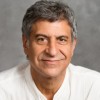The first time I experienced Thai massage, or nuad phaen boran, as it is known in the Thai language, I knew it was something very powerful.
I was traveling with a friend who had recently taken an introductory course, and she wanted to practice some techniques on me. I remember the sensation of palming on my feet and legs, and how nice it felt for my body to be opened and relaxed in that way.
I have no recollection of the other things she did that day, except for one brilliant move; a suspended spinal twist.
As I surrendered to that moment, suspended in space, my head dangling backward and my breath deep and long, I flashed back to earlier times in my life, and I realized that the close connection I once had between my body and my spiritual center had become clouded, and that it needed to become clear again.
There, while suspended in that pose, I knew that I wanted to learn more about this thing called “Thai massage,” so I arranged for a two month journey to investigate further.
That first trip to Thailand in 1999 would set the tone for the next phase of my life; a long period of work in traditional Thai healing arts.
An ancient healing art
At its essence, traditional Thai massage is a balanced blend of physical, energetic and spiritual healing techniques and concepts.
It is the skilful combination of applying both broad and targeted acupressure, finding and dissolving blockages, stimulating energy lines (sen), opening and toning the body with yoga-like stretches, and last but not least, allowing and encouraging the receiver to engage in a process of self healing, deep relaxation and renewal Thai massage is a spiritual healing art, not just a physical therapy.
In Thailand, massage (nuad) belongs to one of the branches of Thai medicine, and it incorporates Buddhist healing principles. Traditional Thai massage has roots which extend back to Indian Ayurvedic medicine and ancient Buddhist medicine, and it evolved in Thailand where stillness and softness are important cultural norms.
Accomplished therapists and teachers understand the power of meditation and stillness while at work, both for the giver and the receiver. They work slowly and in a meditative way, and they always encourage silence.
Good body mechanics and correct breathing also play important roles. The hara, the core area located slightly below the navel, is where all movement should originate.
Individualized, holistic treatments
Traditional Thai massage isn’t a sequence of techniques and movements that can be applied to all people. Teachers and schools that train students to follow proprietary fixed sequences for all clients may be hindering students from growing into deeply sensitive therapists.
Along the way, there must be adaptation, exploration and experience with a wide variety of different people. Generally speaking, only after several years of practice and study can one develop the sensitivity and awareness that is needed to effectively work with each person in an individualized fashion.
Individualized holistic treatment is at the heart of Thai healing arts. Thai massage should be administered in this way in order to be fully effective.
An accomplished Thai therapist continually practices and studies, preferably with a variety of teachers, throughout their entire career. They “listen” to the body of each client as they work, learn to sense energy flow and blockages, and rely on intuition, sensitivity and stillness to guide them through each treatment.
Finding qualified therapists and teachers
The fact that Thai massage inherited passive yoga stretches from the India confuses some students and therapists into believing that Thai massage sessions should be based entirely on assisted yoga techniques, though this is hardly the case.
If your Thai massage therapist simply stretches and compresses you into yoga positions, you are not receiving traditional Thai massage. Mixing Thai massage with other established modalities such as western table massage and yoga is also common.
These hybrid forms may include elements of nuad boran, but they shouldn’t be confused with, or presented as traditional Thai massage.
It’s also important for consumers to thoroughly investigate a prospective therapist before making an appointment for a Thai massage.
Whether searching for a teacher or a therapist, check the person’s study and training history. If it’s not listed on their web site or in their promotional information, ask them how long have they studied Thai massage and with whom. Have they studied in Thailand? If so, when was the last time they were there?
Before you make an appointment or register for a course in Thai massage, check into each person’s background just as you would for a prospective employee, or a tenant for your rental home. To learn more about world standards for the practice and study of traditional Thai massage, or to find a qualified therapist or teacher in your area, visit the Thai Healing Alliance.
Traditional Thai massage has been treating and helping people to improve their physical and spiritual health for a very long time. There is every indication to believe it will continue on this path well into the future.
Like elephant journal on Facebook.
Assistant Editor: Jes Wright/Editor: Bryonie Wise










Read 4 comments and reply